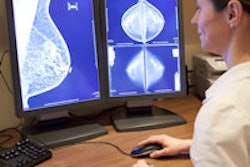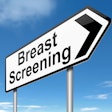A new analysis published in Women's Health Issues has found that mammography screening rates of women 65 years and older dropped immediately after the U.S. Preventive Services Task Force (USPSTF) changed its guidance on breast screening in 2009. The fall arrested what had been years of growth in the breast screening rate.
Monthly breast screening rates for women ages 65 to 90 fell 6% in the year after USPSTF adopted more restrictive guidelines on screening, and three years later they had fallen by a total of 8%, according to lead author Miao Jiang, PhD, of the Harvey L. Neiman Health Policy Institute and George Mason University (Women's Health Issues, May-June 2015, Vol. 25:3, pp. 239-245). The paper also included co-authors Danny Hughes, PhD, and Dr. Richard Duszak Jr.
The new findings are likely to draw attention given USPSTF's announcement in April that it would stick to the 2009 guidelines for its 2015 revision. Many advocates of screening are worried that the task force's failure to expand the number of women covered by breast screening will result in fewer women seeking out exams -- and more deaths from breast cancer.
Changing guidelines
USPSTF changed its guidelines on breast screening in 2009, rescinding its advice that women in their 40s receive regular screening. It also advised that women ages 50 to 74 undergo exams every two years rather than annually, while recommending that women 75 and older receive no screening at all.
Although the guidance change was widely criticized at the time by women's health advocates, the task force reaffirmed its position last month. USPSTF said that after an extensive review of the benefits and harms of mammography, it intends to stick with the more restrictive guidelines. As in 2009, the decision has been controversial.
In their study in Women's Health Issues, Jiang and colleagues wanted to examine the impact of the 2009 decision on breast screening rates in the Medicare population by looking at exams performed between 2005 and 2012. They specifically focused on women 65 to 90, as these women have five times the incidence and 10 times the mortality from breast cancer compared to those younger than 65.
They drew a random 5% sample of claims from Medicare beneficiaries from 2005 through 2012 to determine the number of women who received screening mammography each month per 1,000 female beneficiaries.
The researchers found that the mammography screening rate had been growing prior to the 2009 USPSTF announcement, with 29.9 women per 1,000 receiving mammograms each month across all age groups in 2009. But the rate began falling immediately after the new guidelines, with the change varying by age group.
| Monthly screening rate per 1,000 women after 2009 USPSTF decision | ||||
| Age range | 2009 | 2010 | 2011 | 2012 |
| Age 65-74 | 36.2 | 34.2 | 34 | 33.7 |
| Age 75-84 | 28.6 | 26.1 | 25.5 | 24.9 |
| Age 85-90 | 14.5 | 12.4 | 11.7 | 10.9 |
| Overall (age 65-90) | 29.9 | 27.8 | 27.5 | 27.2 |
The decline amounts to a fall of 6% for women 65 to 90 in the year after the USPSTF change, and 8% after three years. The drop is somewhat consistent with the results of a 2013 study by Sharpe et al, which used a different methodology and found a 4.3% decline in screening from 2009 to 2010.
Why?
What caused the decline in the screening rate? It cannot be attributed to less insurance coverage for screening, as the study focused on Medicare beneficiaries and Medicare continued to pay for screening exams before and after the 2009 guidelines change, the authors noted. Also, two other Medicare screening tests used as controls, Pap smears and eye tests, did not decline during the same period.
"Other issues, such as media coverage, patient and physician confusion, and an overall lack of confidence and conflicting guidelines from USPSTF and other medical societies are probably weighing heavily on physician and patient preferences and behavior," the authors wrote.
The researchers specifically addressed the decline in the screening rate among women 75 and older. Such a drop could represent adherence to the USPSTF guidelines, which do not recommend screening in these women. But that's probably because randomized clinical trials evaluating screening mammography didn't include women older than 74, the authors wrote.
Jiang and colleagues noted that women older than 74 have five times the incidence and 10 times the mortality rate of women ages 65 to 74 and, indeed, American Cancer Society (ACS) guidelines recommend continued screening of women as long as they are in good health. The group recommends more research in this area.
The researchers concluded by saying that when new -- and conflicting -- guidelines are issued, this can prompt physicians and patients to reconsider "longstanding patterns of care."
"Behavioral changes should be anticipated when professional organizations issue competing guidelines; their important public policy implications may impact distinct demographic groups differently, and their results may not be fully quantifiable for many years after their implementation," they wrote.



















